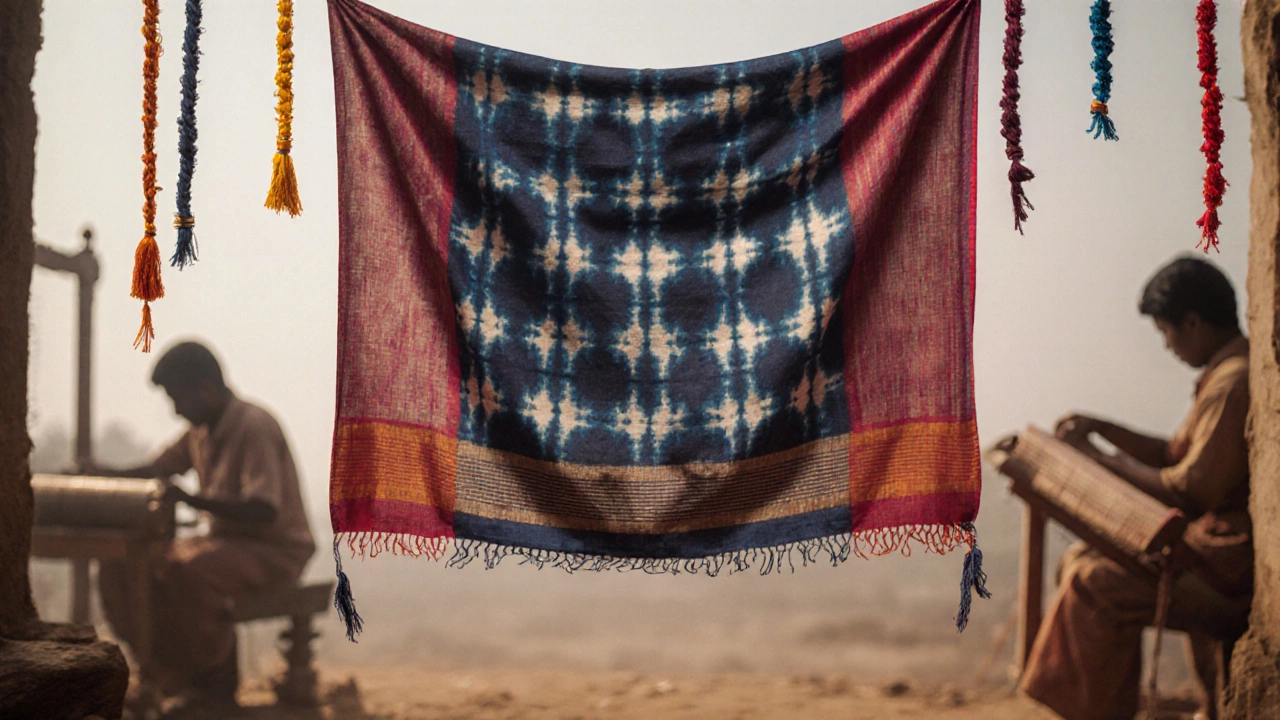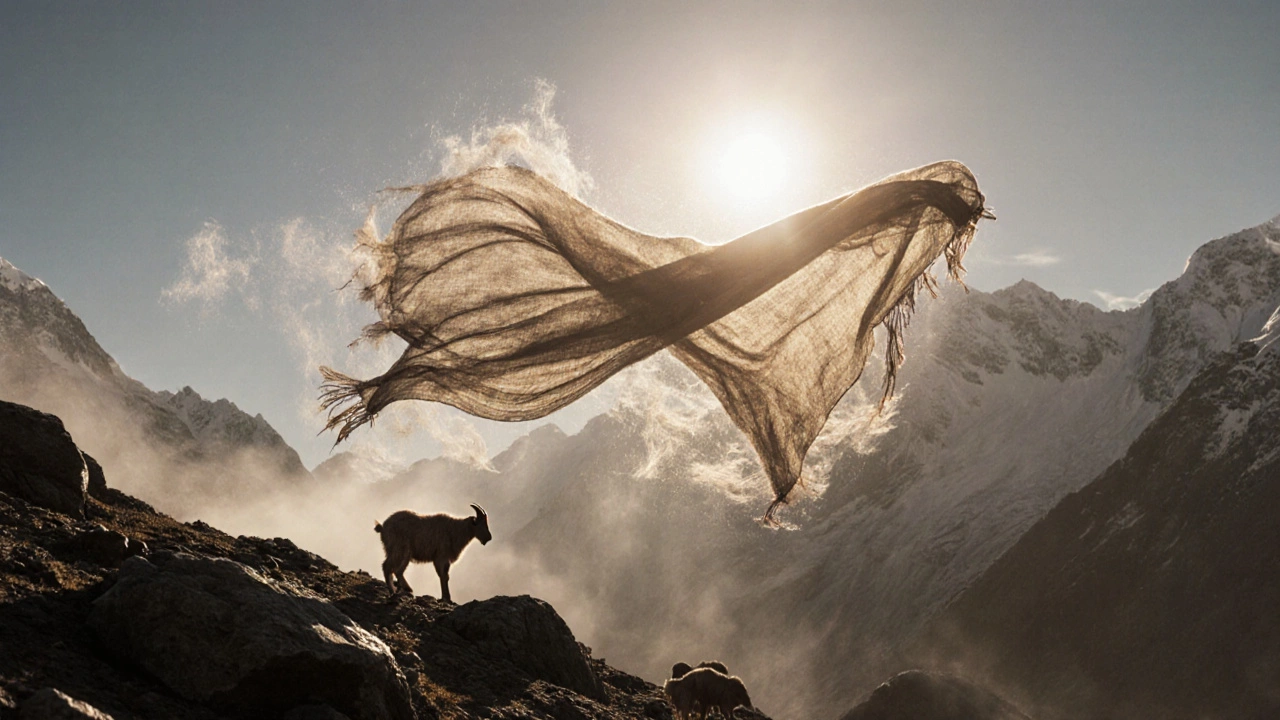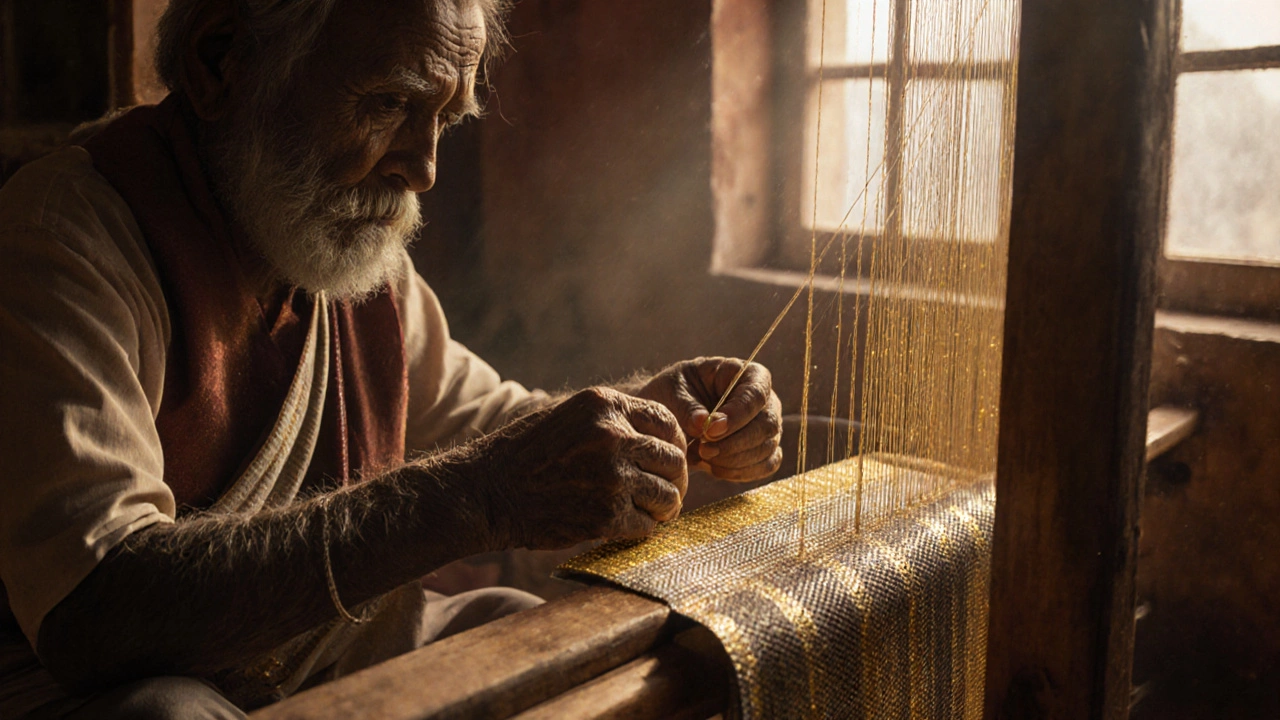Indian Luxury Fabric Cost Calculator
Calculate Your Fabric Cost
Estimated Price
Key Factors
- Time Required:
- Authenticity Check:
- Material Value:
In India, fabric isn’t just material-it’s culture, history, and craftsmanship woven into every thread. While cotton and polyester dominate daily wear, a handful of fabrics carry prices that rival luxury goods worldwide. If you’ve ever wondered what fabric costs more than gold in India, the answer isn’t one-size-fits-all. It depends on origin, labor, rarity, and tradition. Some fabrics cost thousands per meter not because of the raw material, but because of the hands that make them.
Why Some Fabrics Cost More Than Others
Price in Indian textiles isn’t tied to weight or fiber type alone. A single yard of handwoven silk can cost more than a month’s salary for a rural worker. The real cost comes from time, skill, and scarcity. Machine-made fabrics are cheap because machines don’t get tired. Handloom weavers do. And when a weaver spends 30 days weaving one saree, the price reflects more than fabric-it reflects legacy.
Raw materials matter too. Not all silk is the same. Not all wool is equal. The difference between regular mulberry silk and wild Tussar silk? One is farmed. The other is harvested from forests where silkworms feed on wild trees. That alone changes the cost. Add in natural dyes made from insects, roots, and flowers, and you’re not just buying cloth-you’re buying centuries of tradition.
Top Five Most Expensive Fabrics in India
Here are the fabrics that consistently top the luxury list in India today:
- Banarasi Silk - Woven in Varanasi, this silk is famous for its heavy gold and silver zari work. A single Banarasi silk saree can range from ₹25,000 to over ₹5,00,000. The most expensive ones use real silver threads dipped in gold. Some take up to six months to complete. A single saree might use over 2,000 meters of thread.
- Pashmina Wool - Harvested from the undercoat of Himalayan goats in Ladakh, Pashmina is finer than cashmere. A single goat produces only 100-170 grams of wool per year. To make one shawl, you need wool from three to four goats. A pure Pashmina shawl starts at ₹15,000 and can go beyond ₹1,00,000. Fake Pashmina (often blended with acrylic) floods markets, but true Pashmina is warm, lightweight, and doesn’t pill.
- Chanderi Silk - From Madhya Pradesh, Chanderi is known for its sheer texture and subtle shimmer. Made with silk and zari, it’s lighter than Banarasi but just as intricate. Handwoven Chanderi sarees start at ₹18,000 and can reach ₹3,00,000 if they feature rare motifs like peacocks or temple designs.
- Patola Silk - Originating in Patan, Gujarat, this is one of the most complex weaves in the world. Each saree uses the double ikat technique-where both warp and weft threads are tie-dyed before weaving. One mistake ruins the entire pattern. A single Patola saree can take 6-12 months to complete. Prices start at ₹40,000 and go up to ₹8,00,000 for antique pieces.
- Muga Silk - Found only in Assam, Muga silk is golden in color and naturally resistant to sunlight. It’s produced by the Antheraea assamensis silkworm, which can’t be domesticated like mulberry silkworms. Muga silk is durable, lustrous, and never loses its shine. A handwoven Muga silk saree costs between ₹30,000 and ₹2,00,000. It’s so rare that even Indian royalty wear it for state ceremonies.
What Makes These Fabrics So Rare?
These fabrics aren’t expensive because they’re flashy. They’re expensive because they’re disappearing.
Younger generations in weaving communities are leaving for cities. Fewer people want to sit for 12 hours a day, weaving thread by thread, earning ₹150-₹300 per day. The government offers subsidies, but they rarely reach the weavers directly. Many middlemen buy finished pieces for a fraction of their value and sell them as luxury imports abroad.
Raw material shortages are growing too. Pashmina goats are losing grazing land due to climate change. Muga silkworms need specific trees that are being cut down. Natural dyes are being replaced by synthetic ones because they’re faster and cheaper. The result? Authentic pieces are becoming collector’s items.

How to Spot Real vs. Fake Luxury Fabrics
Buying expensive fabric in India means knowing what to look for. Here’s how to avoid being scammed:
- Pashmina: Rub the fabric gently. Real Pashmina will produce a soft, natural fuzz. Fake ones made with polyester won’t. Burn a tiny thread-it should smell like burnt hair, not plastic.
- Banarasi Silk: Check the zari. Real zari is silver wrapped in gold. Fake zari is copper or aluminum foil. Hold it up to light-real zari glows. Fake zari looks dull and flakes off.
- Patola: Look at the reverse side. In a true double ikat, the pattern should be clear on both sides. If it’s blurry on the back, it’s printed, not woven.
- Muga Silk: It has a natural golden sheen that doesn’t fade. Wash a small corner with mild soap. Real Muga will retain color. Fake silk will bleed or turn dull.
Buy from cooperatives or government-certified outlets like Handloom Mark or Geographical Indication (GI) tagged stores. Avoid street vendors selling “authentic Banarasi” for ₹5,000. That’s not silk-it’s a marketing lie.
Who Buys These Fabrics-and Why
These fabrics aren’t just for weddings. While brides still drive demand, a new wave of buyers is emerging: urban professionals, global collectors, and even fashion houses in Paris and Milan.
Designers like Sabyasachi and Anita Dongre use authentic Banarasi and Chanderi in their collections. International brands like Hermès and Gucci have partnered with Indian weavers to create limited-edition scarves and stoles. The global market for Indian luxury textiles is now worth over $1.2 billion annually.
But the real buyers? They’re the ones who understand the story. A woman in Mumbai might pay ₹1.5 lakh for a Patola saree not because it’s beautiful-though it is-but because she knows it took a weaver’s grandmother 11 months to make it. That’s not fashion. That’s heritage.

Is the Future of These Fabrics in Danger?
Yes. And it’s not just about money.
Over 2 million handloom weavers in India are struggling. Many have switched to power looms that produce fake versions of these fabrics in hours. The result? A flood of cheap imitations that confuse buyers and devalue real work.
Organizations like the National Handloom Development Corporation and NGOs like SEWA are trying to help. They train young weavers, set up direct sales platforms, and fight for GI tags to protect authenticity. But change moves slowly.
Buying an authentic piece isn’t just a purchase. It’s a vote. Every time you pay ₹50,000 for a real Pashmina shawl, you’re keeping a 500-year-old craft alive. You’re giving a weaver’s child a chance to go to school instead of working in a factory.
Final Thoughts: Value Beyond the Price Tag
Expensive fabric in India isn’t about status. It’s about survival. The most costly textiles aren’t the ones with the most glitter. They’re the ones with the most history, the most sweat, the most silence.
If you’re looking to buy, don’t chase trends. Chase truth. Look for the weaver’s name. Ask how long it took. See if the shop works directly with artisans. Pay more, but pay with purpose.
Because in India, fabric isn’t just worn. It’s remembered.
What is the most expensive fabric in India?
The most expensive fabric in India is handwoven Patola silk from Gujarat, followed closely by authentic Banarasi silk with real zari and pure Muga silk from Assam. Prices for these can exceed ₹8,00,000 per saree due to the months of handwork, rare materials, and complex weaving techniques involved.
Why is Pashmina so expensive in India?
Pashmina is expensive because it comes from the fine undercoat of Himalayan goats, which produce only 100-170 grams of wool per year. It takes wool from three to four goats to make one shawl. The fibers are hand-spun and handwoven by artisans in Ladakh, and the entire process can take 3-6 months. Authentic Pashmina is also incredibly light, warm, and durable-qualities that synthetic blends can’t match.
Is Banarasi silk really worth the high price?
Yes-if it’s real. Genuine Banarasi silk uses handwoven silk threads with real silver and gold zari, and a single saree can take up to six months to complete. The intricate designs, especially those with temple or floral motifs, are done by master weavers using traditional looms. A ₹50,000 Banarasi saree made this way is an heirloom. A ₹5,000 version is machine-made with synthetic threads and won’t last.
How can I tell if a fabric is truly handwoven?
Look for slight irregularities in the weave-handwoven fabrics aren’t perfectly uniform. Check the backside: if the pattern is as clear as the front, it’s likely handwoven. Machine-made fabrics have identical repeats and sharp, sharp edges. Also, ask where it’s made and if the weaver is named. Reputable sellers will know the weaver’s story.
Are there affordable alternatives to luxury Indian fabrics?
Yes. Look for Tussar silk, which is wild silk and less expensive than Mulberry silk. Cotton silk blends, Chanderi cotton, and Bandhani tie-dye fabrics offer elegance at lower prices. Many cooperatives now sell authentic, handwoven pieces starting at ₹5,000-₹15,000. The key is to avoid fake luxury and support small weavers directly.

